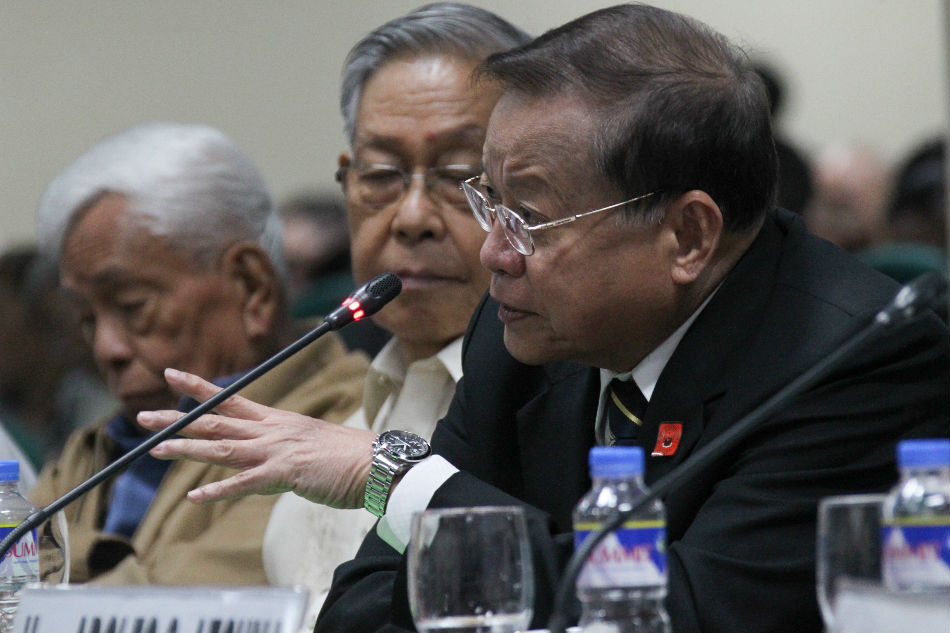Charter review body keeps presidential form in federal shift | ABS-CBN
ADVERTISEMENT

Welcome, Kapamilya! We use cookies to improve your browsing experience. Continuing to use this site means you agree to our use of cookies. Tell me more!
Charter review body keeps presidential form in federal shift
Charter review body keeps presidential form in federal shift
Christian V. Esguerra,
ABS-CBN News
Published Feb 27, 2018 06:54 PM PHT
MANILA—President Rodrigo Duterte’s consultative body on Tuesday went for the “more familiar” presidential form of government under a proposed federalism in a tight vote culminating an 8-hour session.
MANILA—President Rodrigo Duterte’s consultative body on Tuesday went for the “more familiar” presidential form of government under a proposed federalism in a tight vote culminating an 8-hour session.
Former Chief Justice Reynato Puno broke the tie by voting in favor of a federal-presidential model, edging out the proposed semi-presidential setup, 9-8.
Former Chief Justice Reynato Puno broke the tie by voting in favor of a federal-presidential model, edging out the proposed semi-presidential setup, 9-8.
But with no majority of the 18 of 20 members present, the committee went for a runoff where the presidential option defeated the hybrid model, 11-7.
But with no majority of the 18 of 20 members present, the committee went for a runoff where the presidential option defeated the hybrid model, 11-7.
Fr. Ranhilio Aquino, hitherto the lone consultative committee member who picked a federal-parliamentary option, backed the hybrid model during the runoff.
Fr. Ranhilio Aquino, hitherto the lone consultative committee member who picked a federal-parliamentary option, backed the hybrid model during the runoff.
ADVERTISEMENT
“I cast an unhesitating vote for a presidential form of government,” Puno said, assailing the “hybrid” dual executive model.
“I cast an unhesitating vote for a presidential form of government,” Puno said, assailing the “hybrid” dual executive model.
He said he could not “gamble” on the dual executive option where, proponents say, power would be shared between a directly elected president and a prime minister picked by parliament.
He said he could not “gamble” on the dual executive option where, proponents say, power would be shared between a directly elected president and a prime minister picked by parliament.
“It’s undeniable that this hybrid option will be an experiment, a leap to the unknown,” he said. “And I’d like to believe that in designing the structure of our executive power, we cannot afford a system where we see too many moving parts of the puzzle which we have yet to capture.”
“It’s undeniable that this hybrid option will be an experiment, a leap to the unknown,” he said. “And I’d like to believe that in designing the structure of our executive power, we cannot afford a system where we see too many moving parts of the puzzle which we have yet to capture.”
“We all want meaningful change, but this change cannot be hitched on chance,” Puno added.
“We all want meaningful change, but this change cannot be hitched on chance,” Puno added.
Puno cited the need for a “strong center” under a federal Philippines and a president “with such a plenitude of executive powers so he would not fail in leading our people in their continuing odyssey for peace, progress and prosperity”
Puno cited the need for a “strong center” under a federal Philippines and a president “with such a plenitude of executive powers so he would not fail in leading our people in their continuing odyssey for peace, progress and prosperity”
Former Senate President Aquilino “Nene” Pimentel Jr. pushed for a presidential form, saying Filipinos were more familiar with it.
Former Senate President Aquilino “Nene” Pimentel Jr. pushed for a presidential form, saying Filipinos were more familiar with it.
“And knowing the strengths and weaknesses, we can therefore adopt measures that would strengthen it further and remedy its weaknesses,” he told the committee, which will now tackle the fine print of the federal-presidential model.
“And knowing the strengths and weaknesses, we can therefore adopt measures that would strengthen it further and remedy its weaknesses,” he told the committee, which will now tackle the fine print of the federal-presidential model.
The committee is set to have its next plenary session on March 5.
The committee is set to have its next plenary session on March 5.
ADVERTISEMENT
ADVERTISEMENT



